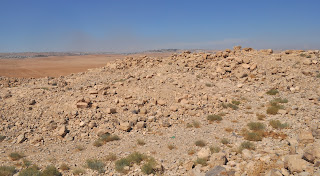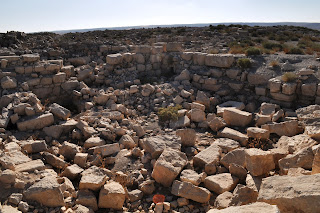After having spent a routine month in Amman at ACOR, I went on a trip to visit Byzantine church sites in the Kerak Plateau. It had been a couple of years since I had last visited these sites.
I went with Firas Bqain, with whom I had gone to Wadi Rum in August and who grew up in Kerak, and Ana Silkatcheva, a younger scholar interested in Byzantine period mosaics whom I had first met only recently; many of the following photographs are by Ana.
The three of us left early in the morning of October 5 and drove to the Kerak Plateau. We stopped first at Khirbat al-Sar, a major site on the southwest side of Amman where an early researcher had identified a church that cannot now be located in the badly disturbed rubble.
We then went to the recently excavated church at el-‘Umayri East, south of Amman.
We then continued to the Roman legionary fortress of el-Lejjun, where I had participated in the excavations in the 1980s, including excavating a church in 1985.
We then went to al-Murayghah, a large site with a church that had been badly bulldozed in the late 1990s.
We then drove through the city of Kerak and down to the highway to the east towards the Dead Sea to a spot where a mosaic floor is exposed in a road cut.
We then drove back up to the plateau to where Firas’ parents live north of Kerak. We had lunch there, before heading out to visit more sites. We went south of Kerak to the village of Umm Hamat, where there are slight remains of a church, as well as a reused lintel with crosses on it that I had not noticed during my previous visits to the village.
We then visited the nearby site of Nakhal with two churches, where I had excavated in 1993. Both buildings have collapsed badly since then.
The next site was the village of Dhat Ras, where there are some Nabataean and Roman remains.
Then came Shuqayrah, the site of an Umayyad palatial estate on the south edge of the Kerak Plateaeu, where the continuing excavations by Muta University have uncovered a great deal since I last visited the site several years ago.
The final stop around sunset was the village of Muhay, where there is a large unexcavated Byzantine church.
We then returned to the house of Firas’ parents, where we had dinner and spent the night.
I went with Firas Bqain, with whom I had gone to Wadi Rum in August and who grew up in Kerak, and Ana Silkatcheva, a younger scholar interested in Byzantine period mosaics whom I had first met only recently; many of the following photographs are by Ana.
The three of us left early in the morning of October 5 and drove to the Kerak Plateau. We stopped first at Khirbat al-Sar, a major site on the southwest side of Amman where an early researcher had identified a church that cannot now be located in the badly disturbed rubble.
The area of the possible church at Khirbat al-Sar
We then went to the recently excavated church at el-‘Umayri East, south of Amman.
Firas and Ana at el-‘Umayri East
We then continued to the Roman legionary fortress of el-Lejjun, where I had participated in the excavations in the 1980s, including excavating a church in 1985.
Firas and I at the church at el-Lejjun
It turns out that the site guard was one of my workmen from the 1987 season, so after we saw the site, we spent some time at his nearby tent.
The group at the site guard’s tent
We then went to al-Murayghah, a large site with a church that had been badly bulldozed in the late 1990s.
The area of the bulldozed church at al-Murayghah
We then drove through the city of Kerak and down to the highway to the east towards the Dead Sea to a spot where a mosaic floor is exposed in a road cut.
Ana pointing to the line of mosaic cubes in the road cut
We then drove back up to the plateau to where Firas’ parents live north of Kerak. We had lunch there, before heading out to visit more sites. We went south of Kerak to the village of Umm Hamat, where there are slight remains of a church, as well as a reused lintel with crosses on it that I had not noticed during my previous visits to the village.
The church at Umm Hamat with the apse curve on the left
The reused lintel with crosses at Umm Hamat
We then visited the nearby site of Nakhal with two churches, where I had excavated in 1993. Both buildings have collapsed badly since then.
One of the churches at Nakhal
The other church at Nakhal
The next site was the village of Dhat Ras, where there are some Nabataean and Roman remains.
The Roman temple at Dhat Ras
Then came Shuqayrah, the site of an Umayyad palatial estate on the south edge of the Kerak Plateaeu, where the continuing excavations by Muta University have uncovered a great deal since I last visited the site several years ago.
The view to the south into the Wadi Hasa from Shuqayrah
The final stop around sunset was the village of Muhay, where there is a large unexcavated Byzantine church.
Firas at the church at Muhay
We then returned to the house of Firas’ parents, where we had dinner and spent the night.













No comments:
Post a Comment